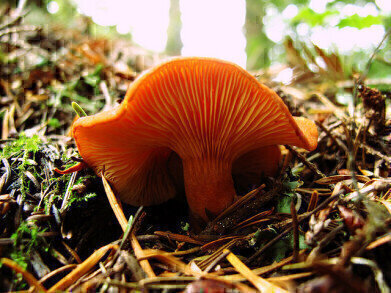GC, MDGC
Why Do Candy Cap Mushrooms Taste Like Maple Syrup?
Nov 06 2014
Candy cap mushrooms have enjoyed something of a boost in popularity in recent years. But they haven’t become more fashionable due to any obscure or exclusive health benefits, or even as part of the über-trendy hipster diet. Candy cap mushrooms are “in” right now because they taste almost exactly like maple syrup!
The unlikely additions to restaurant dessert menus are so reminiscent of the sickly-sweet syrup that candy cap mushroom extract has been used in puddings, ice cream and even cakes. But why do these fungi taste so good for a sweet tooth?
This question has stumped scientists for decades ... until now!
A Mushroom-Crumb Trail to the Truth
Research into the origins of the candy cap’s sweetness began back in 1985, when William Wood, a researcher at the Humboldt State University, decided to get to the bottom of the mystery. Along with colleague Darvin DeShazer, currently the Chairman of the Science Department at St Vincent High School in California, who describes himself on Twitter as “wild mushroom hunter and cerebral engineer”, the pair set to work.
Just 27 years later, they came up with the results. They found that while freshly picked mushrooms don’t smell (or taste) like maple syrup, the combination of amino acids whilst drying produces a chemical called quabalactone III. This, in turn, reacts with water to create sotolon… which is the chemical added by producers of “fake” maple syrup to achieve a similar smell.
And since smell accounts for the majority of taste – voilà! Syrupy goodness awaits. Basically, nature was manufacturing fake syrup through very real and natural methods.
How did the pair (eventually) come to these conclusions? Through the wonders of gas chromatography, that’s how.
Chromatography to the Rescue
Gas chromatography (GC) is the procedure by which compounds are broken down into their individual components, through the process of turning a solid or liquid into vapour and analysing the results.
While chromatography was a known and widespread practice back in 1985 when the investigation began, it alone was not enough to unravel the mystery. On its own, chromatography would yield results which were not pure enough to determine fully what was responsible for the syrupy smell/taste.
However, the recent combination of GC with solid-phase microextraction allowed for smaller samples to be isolated prior to the chromatography process. This helped the team to understand not only the role of sotolon in the production of the maple taste, but also its concentration. In higher concentrations, the mushrooms would take on a spicy, curry-like taste.
Chromatography has something of a track record of reducing the world’s most profound mysteries to child’s play. The practice has been responsible for cracking such culinary conundrums as the relative spiciness of chilli peppers to the purity of the coffee we drink, as well as putting to bed that age-old question which has cost many of us a sleepless night: why does urine smell after eating asparagus?
Image Source: Candy Cap Mushroom
Digital Edition
Chromatography Today - Buyers' Guide 2022
October 2023
In This Edition Modern & Practical Applications - Accelerating ADC Development with Mass Spectrometry - Implementing High-Resolution Ion Mobility into Peptide Mapping Workflows Chromatogr...
View all digital editions
Events
ACS National Meeting - Fall 2024
Aug 18 2024 Denver, CO, USA
Sep 04 2024 Chiba, Tokyo, Japan
Sep 04 2024 University of Warwick, Coventry, UK
Sep 10 2024 Rockville, MD, USA
Plastics Recycling World Expo Europe
Sep 11 2024 Brussels, Belgium














